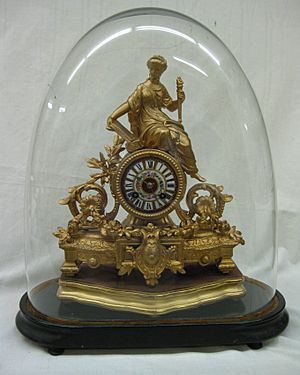Naming of Toodyay, Western Australia facts for kids
The town of Toodyay, Western Australia has an interesting history with its name! It wasn't always called Toodyay. At first, the town was located in what is now West Toodyay. But serious floods kept happening. Because of this, the town center had to move. It relocated to an area near the Newcastle convict depot. This new town was then called Newcastle. After about 50 years, people got confused because there was another big city called Newcastle in New South Wales. So, the name of Newcastle (in Western Australia) was changed to Toodyay. The original Toodyay then became known as West Toodyay.
Contents
Why Toodyay Moved and Changed Its Name
The first town of Toodyay was officially planned in 1836. But after big floods in 1857 and 1859, a decision was made. The town needed to move to a safer spot. This new spot was about 5 kilometers (3 miles) upstream, where the Toodyay Convict Depot was located.
The New Town of Newcastle
The new town was officially named Newcastle on October 1, 1860. It was named after the Duke of Newcastle. He was an important government official in charge of the colonies at the time. The old town of Toodyay still existed, but it didn't grow any bigger.
Confusion and the Famous Clock
By August 1909, the government asked the town of Newcastle to change its name. Why? Because people were getting confused between Newcastle in New South Wales and Newcastle in Western Australia. Mail often went to the wrong place!
One famous example of this mix-up involved a beautiful French ormolu clock. This clock was mistakenly sent to Newcastle, New South Wales, and sat there unclaimed. Sir John Forrest, a well-known figure, realized the clock belonged to William Demasson in Newcastle, Western Australia. He made sure the clock was returned to its rightful owner. This incident really helped push for the name change.
The Name Change to Toodyay
In February 1910, the town council held a vote. By a small majority, people decided to change the town's name to Toodyay. On May 6, 1910, it was officially declared. The town of Newcastle would now be known as Toodyay. And the old town of Toodyay would be called West Toodyay.
The French Ormolu clock stayed with the Demasson family for a long time. In 1987, the National Trust of Western Australia bought it. Later, the clock and its history documents were given to the Toodyay Historical Society. On October 21, 2007, the clock was finally welcomed back to the town of Toodyay.
What Does 'Toodyay' Mean?
The exact meaning or origin of the name Toodyay isn't fully clear. It comes from the Noongar language, from words like Toodye or Duidgee.
Early Ideas About the Name
In 1929, during Western Australia's 100th birthday, a writer named Victor Riseley wrote an article. He was responding to other ideas about the name's origin. Riseley believed that "beautiful," while a perfect way to describe the area, wasn't a word the Ballardong people (an Aboriginal group) would use for a place name. Their place names usually described things needed for daily life. Riseley thought Toodyay came from Toodyeep. She was the wife of a tracker who went with George Fletcher Moore to the valley known as Gabbia-Yandirt in 1836.
Another idea comes from a story written by James Drummond in 1836. He wrote about a group of people claiming land in the area. As they went onto Drummond's land, their guide, Babbing, said a good area with land and water was called Duidgee. This place was popular with the Ballardong people. It had lots of reed mace, whose thick roots were a good source of food.
Newer Theories About the Name
In recent years, experts have suggested other ideas for the name. Professor Len Collard's Noongar language project suggests the meaning is "today it is misty and foggy." Another idea is that the name comes from the sound of a bird, like the restless flycatcher (Myiagra inquieta). This bird's call sounds like duidjee-duidjee or toodjee-toodjee. This bird is common in the Toodyay area and also where Babbing grew up. Anthropologists Ken Macintyre and Barb Dobson think Babbing might have been describing a bird's sound. Drummond didn't ask what the word meant at the time. Macintyre and Dobson also note that Aboriginal people were named after their birthplace, not the other way around. So, they don't think the name Toodyay came from Toodyeep.
By 1842, Drummond was using Toodyay to refer to the area in his letters. He called a pool on his property Duidgee Catta.


